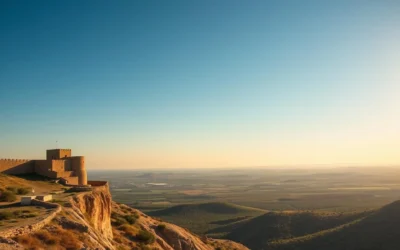Did you know that Jerash is home to one of the best-preserved Roman cities outside of Italy, with an estimated 90% of the ancient site still waiting to be excavated? This archaeological wonder, often called the “Pompeii of the Middle East,” offers visitors a remarkable journey through time, where 2,000-year-old colonnaded streets, grand temples, and impressive theaters stand as testament to the grandeur of the Roman Empire.
Plan Your Jerash Adventure
Ready to explore this ancient wonder? Start planning your trip with these essential services:
Find Flights
Book Accommodations
Rent a Car
Browse Tours & Activities
Introduction to Ancient Jerash
Jerash, once known as Gerasa, is an extraordinary archaeological site with a history dating back to 7500 BCE. Located just 48 km north of Amman, Jordan’s capital, this ancient city flourished under Roman rule and became one of the most important cities in the Roman province of Arabia. Today, its remarkably preserved ruins offer visitors a unique opportunity to walk through history.
Historical Significance
Founded by Alexander the Great in 331 BCE, Jerash truly flourished after the Romans conquered it in 63 BCE. The city reached its golden age during the 2nd and 3rd centuries CE when it was a thriving commercial center along important trade routes. Despite being damaged by an earthquake in 749 CE and later conflicts, Jerash’s Roman architecture has remained remarkably intact, making it one of the most significant Roman sites outside Italy.
Brief Timeline of Jerash
- 7500 BCE: Evidence of earliest human settlement in the area
- 331 BCE: Alexander the Great establishes the city
- 63 BCE: Romans conquer Gerasa
- 106 CE: Gerasa becomes part of the Roman province of Arabia
- 129-130 CE: Emperor Hadrian visits, and Hadrian’s Arch is built in his honor
- 2nd-3rd centuries CE: Jerash reaches its peak prosperity
- 400-600 CE: The city becomes an important Christian center
- 749 CE: A devastating earthquake damages much of the city
- Early 19th century: Rediscovery of the ruins by European explorers
How to Get to Jerash from Amman
Located just 48 km north of Amman, Jerash is easily accessible by several transportation options. Each method offers different advantages depending on your travel style and budget.
By Rental Car
Renting a car gives you the freedom to explore at your own pace. The drive from Amman to Jerash takes approximately 45-60 minutes depending on traffic. The route is well-marked and the roads are generally in good condition.
By Taxi
Taking a taxi is a convenient option if you prefer not to drive. A private taxi from Amman to Jerash will cost around 35-40 JOD (approximately $50-56 USD) for a round trip, with the driver waiting while you explore the ruins.
By Public Bus
For budget travelers, public buses run regularly from Amman’s Tabarbour Bus Station (North Bus Station) to Jerash. The journey costs only 1 JOD (about $1.40 USD) each way and takes 45-60 minutes. Buses depart when full, so plan accordingly.
Organized Tours
Many visitors opt for organized day tours from Amman, which often combine Jerash with other nearby attractions like Ajloun Castle. These tours typically include transportation, entrance fees, and a guide, making them a hassle-free option for exploring the ruins.
Recommended Tours to Jerash
Save time and enhance your experience with a guided tour that includes transportation from Amman:
Best Time to Visit and Practical Information
Jerash can be visited year-round, but certain seasons offer more comfortable conditions for exploring the extensive ruins. The site’s opening hours vary by season to accommodate daylight hours and visitor patterns.
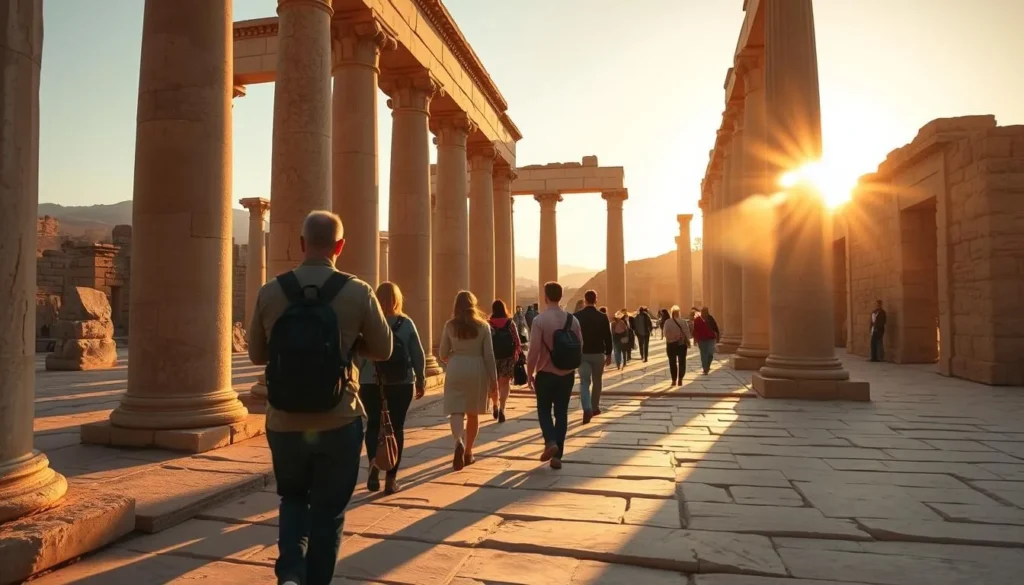
Seasonal Considerations
| Season | Temperature | Conditions | Recommendation |
| Spring (March-May) | 15-25°C (59-77°F) | Mild temperatures, occasional rain, wildflowers blooming | Highly recommended – ideal weather for exploring |
| Summer (June-August) | 25-35°C (77-95°F) | Hot and dry, strong sun | Visit early morning or late afternoon, bring plenty of water |
| Fall (September-November) | 15-28°C (59-82°F) | Pleasant temperatures, occasional rain later in season | Excellent time to visit with fewer crowds |
| Winter (December-February) | 5-15°C (41-59°F) | Cool temperatures, possible rain, occasional snow | Less crowded but bring warm clothing |
Opening Hours and Entrance Fees
- November to March: 8:00 AM to 4:00 PM
- April to May: 8:00 AM to 5:30 PM
- June to October: 8:00 AM to 6:30 PM
- Ramadan: 9:00 AM to 5:00 PM
- Entrance Fee: 12 JOD (approximately $17 USD)
- Jordan Pass: Includes entry to Jerash and over 40 other attractions
Pro Tip: If you’re planning to visit multiple attractions in Jordan, consider purchasing the Jordan Pass before your trip. Starting at 70 JOD ($99 USD), it includes your tourist visa fee and entrance to over 40 attractions including Petra, Wadi Rum, and Jerash.
Essential Items to Bring
- Comfortable walking shoes – You’ll be covering several kilometers on uneven terrain
- Sun protection – Hat, sunglasses, and sunscreen are essential, especially in summer
- Water bottle – Stay hydrated while exploring the extensive site
- Camera – The photogenic ruins offer countless picture opportunities
- Light jacket – Even in summer, evenings can be cool
- Small backpack – For carrying your essentials comfortably
- Snacks – Options within the site are limited
- Cash – For entrance fees, souvenirs, and refreshments
Top Attractions in Jerash: Must-See Ruins
The archaeological site of Jerash is vast, covering over 800,000 square meters. Plan to spend at least 3-4 hours exploring the main attractions. Here are the highlights you shouldn’t miss during your visit.
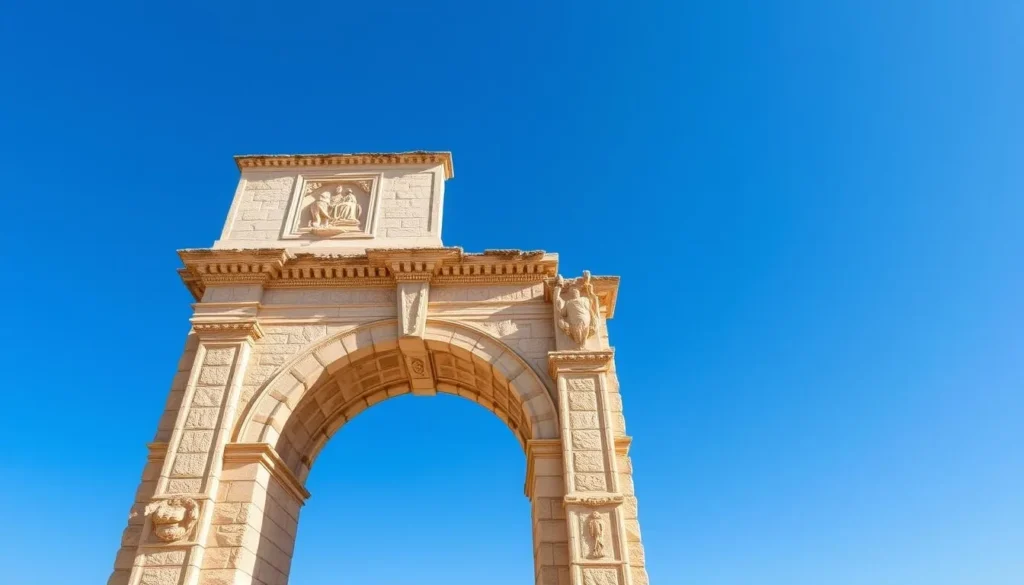
Hadrian’s Arch and South Gate Complex
Your journey through ancient Jerash begins at Hadrian’s Arch (also known as the Triumphal Arch), an impressive 21-meter high structure built in 129 CE to commemorate Emperor Hadrian’s visit to the city. This ornate gateway stands as a proud testament to Roman architectural prowess and marks the entrance to the ancient city.
Just beyond the arch lies the Hippodrome, an ancient sports arena where chariot races and athletic competitions once entertained up to 15,000 spectators. Today, visitors can sometimes witness reenactments of Roman army drills and chariot races, offering a glimpse into the entertainment of ancient Gerasa.
Experience Jerash Like a Local
Enhance your visit with a knowledgeable guide who can bring the ancient city to life:

The Magnificent Oval Plaza and Colonnaded Streets
The Oval Plaza (Forum) is one of Jerash’s most distinctive features and a masterpiece of Roman urban planning. This unique oval-shaped public space is surrounded by a colonnade of tall Ionic columns and still features its original limestone paving stones. The plaza once served as the city’s social and political heart, connecting to the main colonnaded street.
From the Oval Plaza, the impressive Cardo Maximus stretches northward for 800 meters. This straight, column-lined street was the city’s main thoroughfare, with shops and public buildings lining both sides. Look down to see the original stone paving, complete with chariot wheel ruts and a sophisticated underground sewage system that demonstrates the advanced engineering of ancient Romans.
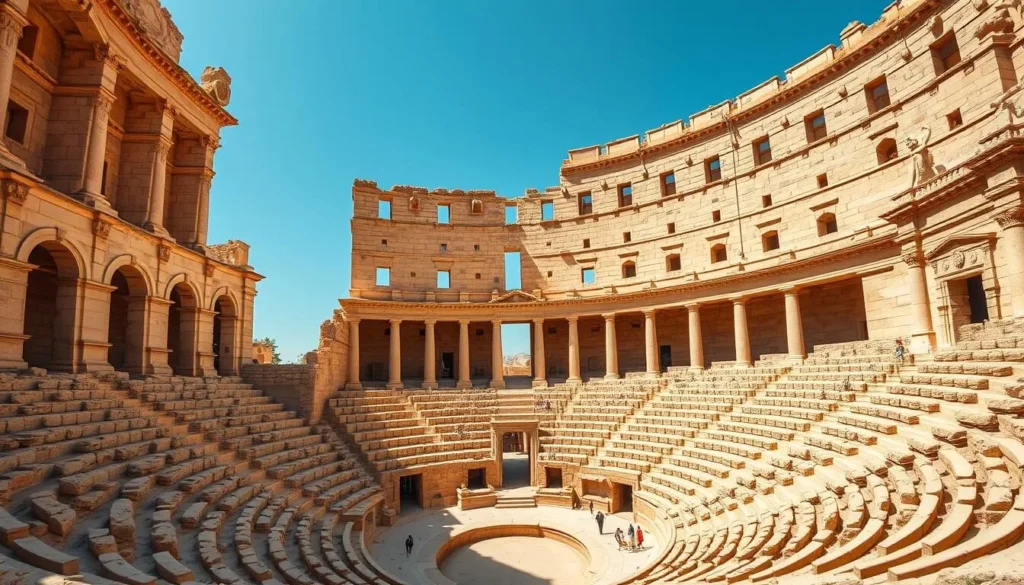
Ancient Theaters and Performance Venues
Jerash boasts two remarkably well-preserved Roman theaters. The South Theatre, built around 90 CE, could accommodate more than 3,000 spectators and features exceptional acoustics. Stand in the center of the orchestra floor and speak in a normal voice – you’ll be amazed at how your words carry to the highest tiers of seating. During the annual Jerash Festival of Culture and Arts (typically held in July), this ancient venue comes alive with modern performances.
The smaller North Theatre, originally built for city council meetings rather than public performances, was later expanded to seat about 1,500 people. Both theaters offer fascinating insights into Roman entertainment and civic life, as well as spectacular views over the ruins from their upper tiers.

Temple of Artemis and Religious Sites
The Temple of Artemis stands as one of Jerash’s most impressive structures. Built in the mid-2nd century CE and dedicated to the city’s patron goddess, this grand temple features 11 of its original 12 towering Corinthian columns, each standing 12 meters tall. The temple’s strategic position on a hill overlooking the city underscores the importance of Artemis worship in ancient Gerasa.
As Christianity spread through the Roman Empire, Jerash became an important religious center. The site contains the ruins of at least 15 Byzantine churches built between the 4th and 7th centuries CE. Many feature beautiful mosaic floors that reflect the artistic and religious transition from pagan to Christian worship. The Cathedral, the Church of St. Theodore, and the Churches of St. Cosmas and St. Damian are particularly noteworthy for their architectural elements and mosaics.
“The columns of the Temple of Artemis are designed to sway slightly in the wind – a sophisticated engineering technique that has helped them survive earthquakes for nearly two millennia. Ask a local guide to demonstrate this remarkable feature with a simple coin or spoon placed between the column segments.”
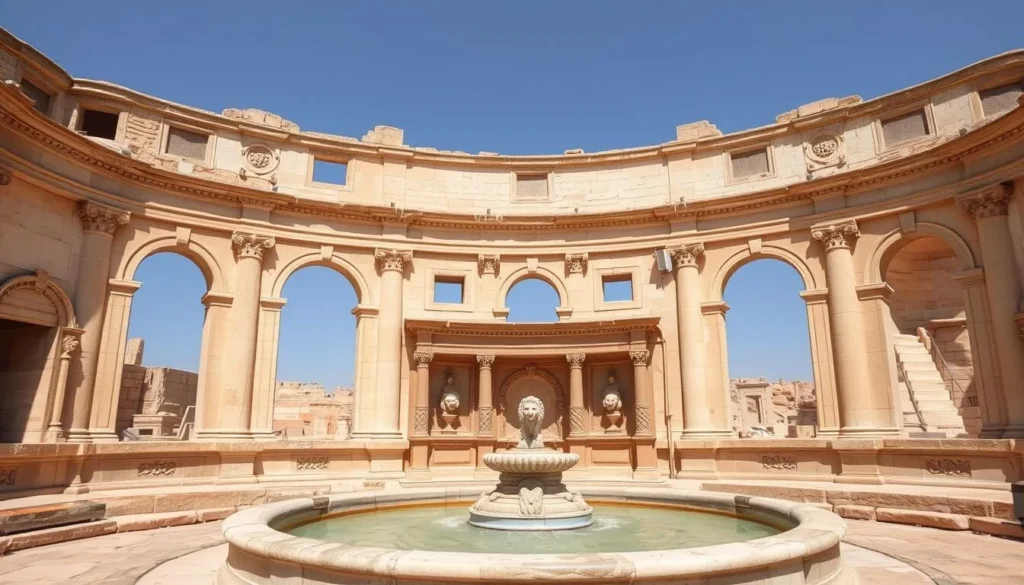
The Nymphaeum and Water Features
The Nymphaeum, an ornate public fountain dedicated to the water nymphs, demonstrates the Romans’ sophisticated approach to both practical infrastructure and beautiful public spaces. Built in the 2nd century CE, this two-story structure once featured marble facings, intricate carvings, and seven lion heads from which water cascaded into a large basin below.
Water management was crucial to Roman city planning, and Jerash showcases numerous examples of advanced hydraulic engineering. Look for the remains of aqueducts, water channels, and public baths throughout the site, all testifying to the Romans’ mastery of water collection and distribution in this semi-arid region.
Planning Your Visit: Tips and Recommendations
To make the most of your time at Jerash, consider these practical tips from experienced travelers who have explored this magnificent archaeological site.

Timing Your Visit
- Arrive early – The site opens at 8:00 AM, and morning visitors enjoy cooler temperatures and fewer crowds
- Allow enough time – Plan for at least 3-4 hours to properly explore the main attractions
- Avoid Fridays – This is the weekend in Jordan, so the site tends to be more crowded with local visitors
- Consider seasonal events – The Jerash Festival of Culture and Arts (usually in July) offers a unique opportunity to experience performances in the ancient theaters
Enhancing Your Experience
- Hire a guide – Local guides offer valuable historical context and can point out easily missed details
- Download an audio guide – Several apps offer self-guided tours of Jerash
- Follow the natural path – The site has a logical flow from south to north
- Look for demonstrations – Guides often demonstrate the columns’ earthquake-resistant design
- Check for performances – The Roman Army and Chariot Experience (RACE) offers regular shows at the Hippodrome
- Visit the museum – The small on-site museum displays artifacts found during excavations
Complete Your Jordan Adventure
Jerash is just one of Jordan’s many treasures. Extend your journey to include these other remarkable destinations:

Dining and Refreshments
Food options within the archaeological site are limited to a small cafeteria and a few vendors selling snacks and drinks. For a more substantial meal, consider these options:
- Lebanese House Restaurant – Located near the site entrance, offering traditional Jordanian and Lebanese cuisine
- Jerash Rest House – A popular spot for visitors with a varied menu of local and international dishes
- Downtown Jerash – The modern city offers several authentic local restaurants serving traditional Jordanian specialties like mansaf (the national dish of lamb cooked in yogurt sauce and served with rice)
Important: During the summer months, temperatures can reach 35°C (95°F). Bring plenty of water, wear sun protection, and take breaks in shaded areas to avoid heat exhaustion while exploring the expansive ruins.
Where to Stay Near Jerash
While many visitors explore Jerash as a day trip from Amman, staying overnight allows you to experience the site without the crowds and explore the surrounding area at a more relaxed pace.
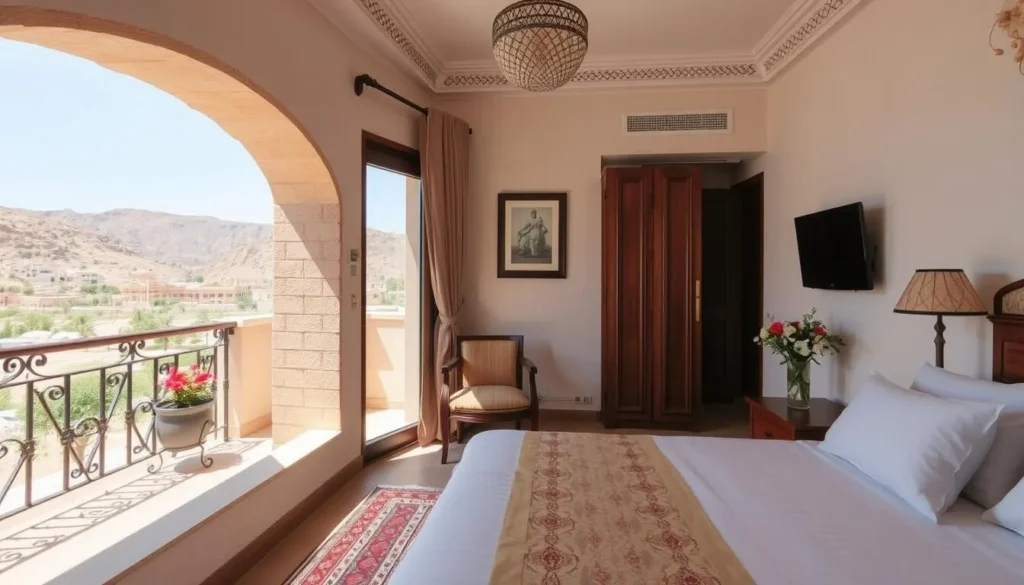
Accommodation Options
In Jerash
The modern city of Jerash offers a few accommodation options within walking distance of the archaeological site:
- Olive Branch Hotel
- Hadrian’s Gate Hotel
- The Ruins Guesthouse
In Amman
Most visitors base themselves in Amman, which offers a wider range of accommodation options and is just a 45-60 minute drive from Jerash:
- Luxury: Four Seasons Hotel Amman
- Mid-range: The House Boutique Suites
- Budget: Sydney Hotel
Unique Stays
For a more authentic experience, consider these unique accommodation options in the region:
- Dibeen Eco Farm (near Jerash)
- Ajloun Forest Reserve Cabins
- Local homestays in villages near Jerash
Beyond Jerash: Nearby Attractions
While Jerash is undoubtedly a highlight of northern Jordan, the surrounding region offers several other fascinating destinations that can easily be combined with your visit.
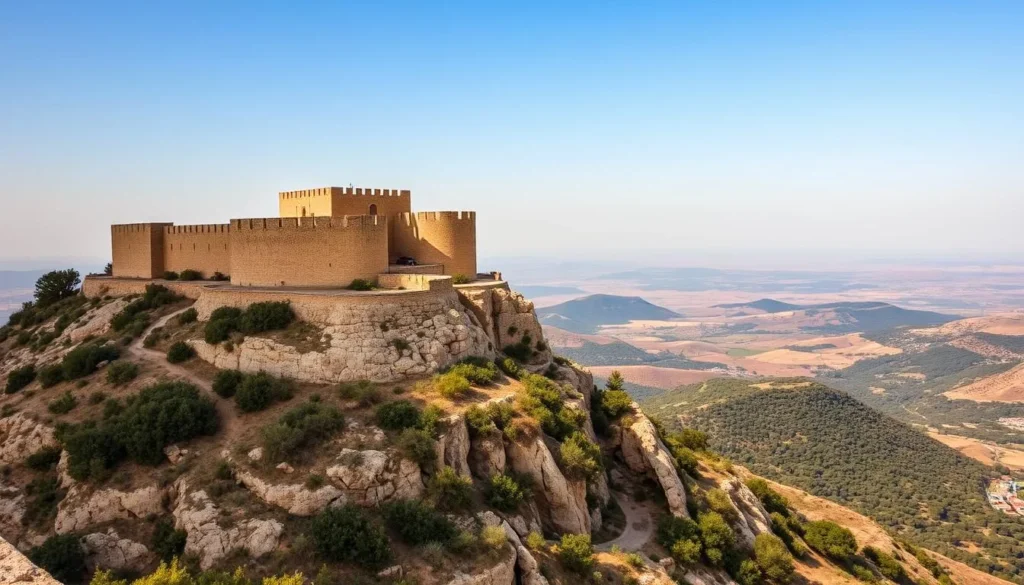
Ajloun Castle
Just 21 km from Jerash, Ajloun Castle (Qal’at Ar-Rabad) is a magnificent 12th-century Muslim castle built by one of Saladin’s generals. Perched atop a hill with panoramic views, this fortress was strategically positioned to protect the region from Crusader attacks and control the iron mines of the area. Today, visitors can explore its impressive chambers, corridors, and towers while learning about medieval Islamic military architecture.
Umm Qais
Located about 50 km north of Jerash, Umm Qais (ancient Gadara) offers another remarkable Greco-Roman site with the added bonus of spectacular views over the Sea of Galilee, the Golan Heights, and the Jordan Valley. The site features a well-preserved Roman theater, basilica, and colonnaded street, along with a museum housed in an Ottoman-era building.
Dibeen Forest Reserve
Nature lovers should consider visiting Dibeen Forest Reserve, located just 10 km from Jerash. This protected area covers 8.5 square kilometers of pristine pine-oak habitat and offers hiking trails, picnic areas, and the chance to spot wildlife including the Persian squirrel and various bird species.
Explore Northern Jordan
Make the most of your time in the region with a tour that combines multiple attractions:
Cultural Tips and Etiquette
Jordan is known for its hospitality and welcoming attitude toward visitors. However, being mindful of local customs and traditions will enhance your experience and show respect for the local culture.

Dress Code
Jordan is a predominantly Muslim country with conservative dress standards, especially outside major tourist areas:
- Both men and women should avoid shorts that fall above the knee
- Women should avoid sleeveless tops and very tight-fitting clothing
- Carry a light scarf to cover your head if visiting mosques
- At archaeological sites like Jerash, practical clothing and sun protection are important, but still aim for modest coverage
Social Customs
- Greet people with “As-salamu alaykum” (peace be upon you)
- Accept offers of tea or coffee when extended – it’s a sign of hospitality
- Use your right hand for eating, shaking hands, and passing items
- Ask permission before photographing local people
- Remove shoes when entering someone’s home
- Avoid public displays of affection
- During Ramadan, avoid eating, drinking, or smoking in public during daylight hours
- Bargaining is expected in markets but should be done respectfully
Language Basics
While English is widely spoken in tourist areas, learning a few Arabic phrases will be appreciated:
- Marhaba – Hello
- Shukran – Thank you
- Min fadlak/fadliki – Please (male/female)
- Ma’a salama – Goodbye
- Kam hatha? – How much is this?
Practical Travel Tips
These final practical tips will help ensure your visit to Jerash is smooth and enjoyable.
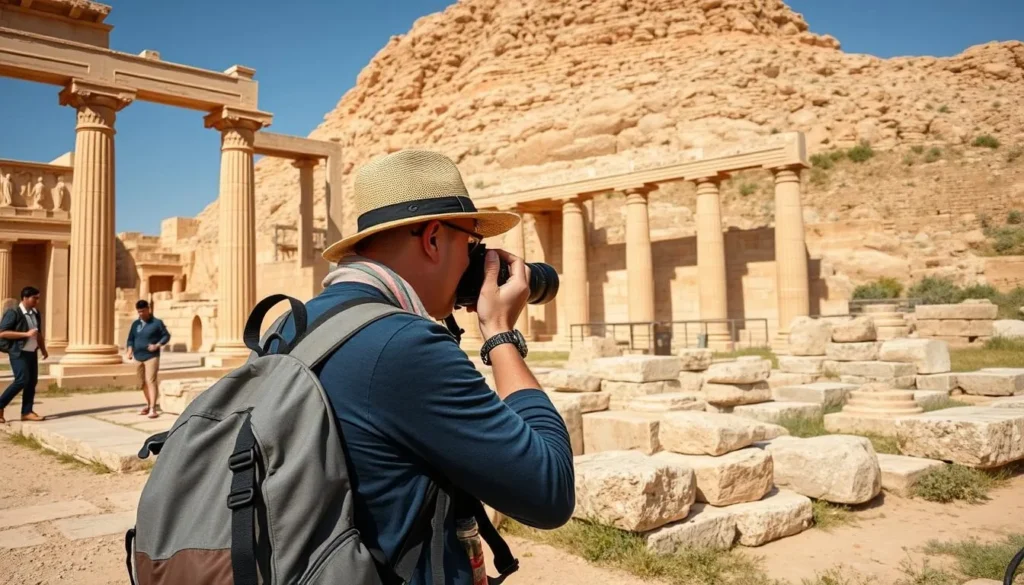
Money and Payments
- The Jordanian Dinar (JOD) is the local currency
- Credit cards are accepted at the ticket office and larger restaurants, but carry cash for smaller vendors
- ATMs are available in modern Jerash town but not at the archaeological site
- Tipping (baksheesh) is customary for guides and good service
Health and Safety
Jordan is generally a very safe country for tourists, but take these precautions:
- Drink bottled water and avoid ice in drinks
- Use sun protection and stay hydrated, especially in summer
- Wear sturdy shoes for walking on uneven ancient surfaces
- Basic medical facilities are available in Jerash, with more comprehensive care in Amman
- Purchase travel insurance that covers medical emergencies
Communication
- Purchase a local SIM card upon arrival in Jordan for affordable data and calls
- Major providers include Zain, Orange, and Umniah
- Free Wi-Fi is available at most hotels and some cafes
- Download offline maps before your visit
How much time should I allocate for visiting Jerash?
Plan to spend at least 3-4 hours exploring the main attractions of Jerash. History enthusiasts might want to allocate a full day to thoroughly appreciate all the site has to offer. The ruins cover a large area, and there’s significant walking involved.
Is Jerash suitable for children?
Yes, Jerash can be enjoyable for children, especially those interested in history. The wide-open spaces allow kids to move around freely, and the chariot shows at the Hippodrome are particularly entertaining for younger visitors. However, be prepared for significant walking and bring plenty of water and sun protection.
Is the Jordan Pass worth it if I’m only visiting Jerash?
If Jerash is your only planned attraction, the Jordan Pass may not be worth it. However, if you’re also visiting Petra (which has a high entrance fee of 50-90 JOD depending on duration) and a few other sites, the Jordan Pass quickly becomes economical. It also includes your tourist visa fee if staying at least 3 nights in Jordan.
Conclusion: The Timeless Wonder of Jerash
Walking through the ancient streets of Jerash offers a remarkable journey back in time, allowing you to experience one of the best-preserved Roman provincial cities in the world. From the grandeur of Hadrian’s Arch to the perfect acoustics of the South Theatre, from the unique Oval Plaza to the towering columns of the Temple of Artemis, Jerash presents an unparalleled glimpse into the sophistication of ancient Roman urban planning and architecture.
Whether you visit as a day trip from Amman or as part of a longer exploration of Jordan’s northern treasures, Jerash will leave you with a deeper appreciation for the rich layers of history that have shaped this fascinating region. As you walk the same stone-paved streets that have supported travelers for two millennia, you become part of the continuing story of this extraordinary archaeological wonder.
Ready to Explore Ancient Jerash?
Start planning your journey to this remarkable archaeological treasure:
Find Flights
Book Accommodations
Rent a Car
Browse Tours & Activities
The above is subject to change.
Check back often to TRAVEL.COM for the latest travel tips and deals.






